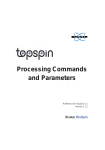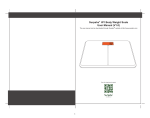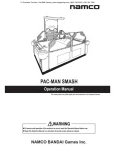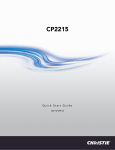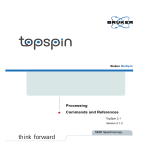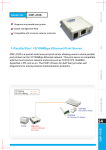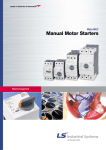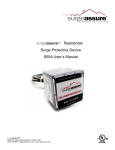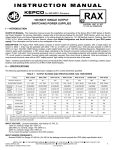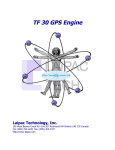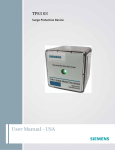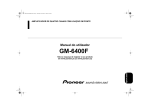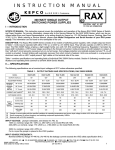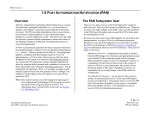Download RACK-3030 CTI CHASSIS USER`S MANUAL
Transcript
RACK-3030 CTI CHASSIS USER’S MANUAL Ver 2.0 Copyright Notice This document and product is copyrighted, September 2000, by ICP Electronics Inc. All rights are reserved. No part of this manual may be reproduced, copied, or translated without prior notice to ICP Electronics Inc. The information provided in this document is for reference only. We do not assume any responsibility arising out of the application of the products. This manual is subject to change without any notice. Rack-3030, IEI are trademark of ICP Electronics Inc. 1 Table of Contents Chapter 1 Product Information 1.1 General Information 1.2 Product Specifications 1.3 Mechanical Dimension Chapter 2 Installation Procedure 2.1 Removing the chassis cover 2.2 Disk Drives Installation 2.3 The Filter 2.4 Backplanes Installation 2.5 Power Supply Installation Chapter 3 Removable Fan 3.1 Introduction 3.2 The Fan signal and connection Chapter 4 Fault Resilient Function 4.1 Introduction 4.2 Fault Detection and Alarm Notification 4.3 Visible Alarm and Audible Alarm Chapter 5 Power Supply 5.1 Single Power ACE-935A 5.2 Redundant Power ARH-6400F (For ATX) 5.3 Redundant Power ARH-4400F (For AT) 2 Chapter 1 Product Information 1.1 General Information Rack-3030 is our new CTI chassis designed specially for Industrial Computer and Telephony application. Built-in fault detection, alarm notification capabilities, to name some of the special features of the product. These special features will prevent your system from shutting down without prior notice. The fault detection and alarm notification can detect the temperature of CPU, chassis, speed of the fan, fan failure, power failure conditions . Rack-3030 is designed to work in harsh environment, it will withstand shock, vibration, and a wide range of operating temperatures. The chassis is equipped with 4 cooling fans for air inlet in the front and 2 cooling fan for air outlet in the both side to ensure a good cooling system for full loading in Telephony system. 1.2 Product Specifications General specification - Chassis - Construction - Cooling Fan : : : 19” Rack mount , 6 U 20-slot. Heavy-duty steel. 4 Fan (92x92mm) front remove & air inlet. 2 Fan(60x60mm) side remove & air outlet. Ball bearing. - Disk Driver : 2 Types of devices cages(big cages & small cage). Two big cages for 2 devices of 5.25” or 4 devices of 3.5”. One small cage for 3 devices of 3.5”. - Indicator : Two LED- fan failure & power on. - Speaker : Buzzer. - Temperature sensor: Case & system. - Maintenance : Desktop with rubber foot. Bottom cover can be removed with maintenance opening. - Dimension : W431(481.8)xD520xH267 mm 3 Backplanes We provide variant of backplanes to be applied with the Rack-3030 depends or your demands: BP-20S, BP-20SD, BP-20ST, BP-20SQ, PCI-18SD, PCI-19S, PX-19S, PX-20S, PX-20S2. Power Supply The Rack-3030 comes with our ACE-935A– the Single Power Supply or with the Horizontal type Redundant Power Supply of ARH-6400F(for ATX) or ARH-4400F(for AT). See Chapter 5 for the detail description of the power supply. Working Environment - Operating Temperature - Relative Humidity - Vibration : : : - Shock : 0~50°C 5~95% Relative 5-17 Hz, 0.1” double amplitude displacement 17-500 Hz, 1.5G acceleration peak to peak 10G acceleration peak to peak 4 1.3 Mechanical Dimension 519.7 516.7 Figure 1.1 and figure 1.2 below show the dimension of the Rack-3030 TOP VIEW 519.7 57.2 88.9 88.9 RESET 266.6 88.9 40.0 431.0 3.0 464.6 128.0 92.1 92.1 92.1 518.5 481.8 FRONT VIEW RIGHT SIDE VIEW BOTTOM VIEW 230 REAR VIEW Figure 1.1 5 516.7 519.7 TOP VIEW 519.7 57.2 88.9 88.9 RESET 266.6 88.9 40.0 431.0 3.0 464.6 128.0 92.1 92.1 92.1 518.5 481.8 FRONT VIEW RIGHT SIDE VIEW BOTTOM VIEW 115 115 REAR VIEW Figure 1.2 6 Chapter 2 Installation Procedure To install the Rack-3030, please read this chapter carefully and prepare all the cards that you would like to install in the chassis to save time. The control panel functions of Rack-3030 include Rocker Switch for Power ON/OFF, System Reset (3 reset for options) , Buzzer ON/OFF, and Two LED indicators: Fan failure for one of four fan, Power On to monitor the system’s status. To set up the system, please follow the steps below: 2.1 Removing the chassis cover The cover is mounted by 2 captive screws at the front of the chassis, remove them by push the sink pool and slide the cover to the rear of the chassis. See figure 2.1. Figure 2.1 7 2.2 Disk Drives installation The disk drivers are fastened inside device cages which will allow you to install and re-install the drive without removing the cover of the chassis. 1. Remove the 2 captive screws on the front of device cage. 2. Remove the device cage by slide it towards the front of the chassis. Please refer to figure 2.2 & 2.3 for the disk drives installation. Figure 2.2 Figure 2.3 8 2.3 The Filter The filter of the Rack-3030 is located at the upper side of the front panel. The filter should be removed and cleaned at least once a month to achieve optimum performance. The filter can be removed by remove 6 screws from Fan Modules. Take out the old filter, replace it with the new one if it’s already worn out. Then fasten 6 screws to put it back. (Figure 2.4) Filt er Filt er Figure 2.4 9 2.4 The Backplanes installation There are variant of backplanes to be applied with the Rack-3030 depends or your demands: BP-20S, BP-20SD, BP-20ST, BP-20SQ, PCI-18SD, PCI-19S, PX-19S, PX-20S, PX-20S2. Figure 2.5 &2.6 below illustrates how to install the backplanes on the Rack3030. Figure 2.5 Figure 2.6 10 2.5 Power Supply Installation If the Rack-3030 is installed with the Horizontal type Redundant Power Supply and you may simply install it by plug the Power unit into the case as shown in the figure 2.7 below. Figure 2.7 11 Chapter 3 Removable Fan 3.1 Introduction The removable fan module is one of the unique features of Rack-3030 where you may remove and install the fan from the front of the chassis without opening the chassis cover. This will give you more convenient and flexibility to replace the fan if necessary.(Fig 2.4 & 3.1) 3.2 The Fan signal and Connection Figure 3.2 below showed the fan signal and how to connect it to the cable of the control panel. Figure 3.1 12 To Po we rS up ply PO WE R CO RD W BL HITE UE BL BR ACK OW N Figure 3.2 13 Chapter 4 Fault Resilient Function 4.1 Introduction The fault resilient of Rack-3030 is a fault detection and alarm notification system. When any fail function occurs, the unit will alert the users. RACK-3030 control panel is built up from ALARMBOARD A60 MODULE. Fan sensor: FAN1、FAN2、FAN3 and FAN4 The RED LED indicator located at the front door will light if one fan failed. Buzzer on/off button x 1: control buzzer on / off. When the system buzzer is alarming, push the button will stop the buzzer. Reset button x 4: (option) Four reset buttons are available to control individual multi system installation. 4.2 Fault Detection and Alarm Notification The Rack-3030 the system fault conditions that will be detected are: Fan Failure: If any of the cooling fan fails. Power Failure: If any of the power fails. 4.3 Visible Alarm However, the alarm indicator (LED) will stay blinking until the fault condition is solved. The fault condition include Fan Failure, Power Failure, the system. 14 A60 JP1 JP4 JP3 JP6 JP5 JP8 To Power Supply Connector(4p) M 20C 70 CM 60C M M 30C M 22C M 2 2C M 22C M 22C M 20C M 20C M 30C M 0C 10 M 30C M 30C To Power Cord ED NL D R O LE WE FAIL O P AN F To System CM 80 Reset Button FOR CLEAR SYSTEM 15 Chapter 5 Power Supply 5.1 Single Power ACE-935A 5.1.1 INPUT SPECIFICATIONS l l l Input Voltage The range of input voltage is from 85V AC to140VAC or 170VAC to 270VAC selected by slide switch install in rear panel of the metal box. Input frequency The range of input voltage is from 47 HZ to 63 HZ Inrush current The inrush current will not exceed 15A at 115V AC input or 30A at 230V AC input cold start,25℃. 5.1.2 OUTPUT SPECIFICATIONS l The load range Output# 1 2 3 4 Output +5V +12V -12V -5V min.load 3.0A 0.1A 0A 0A rated load peak load 40A 10A 8A 0.7A 0.3A Voltage accuracy 5.00V to 5.10V 11.28V to 12.72V -11.40V to –12.60V -4.75V to –5.25V At factory, all outputs in 50﹪rated load condition, the +5V output is set to between 4.90V and 5.10V.The other outputs are checked to be within the specified voltage accuracy range. l Output power The total DC continuous power shall be kept within (300W).Peak load on each output can’t be allowed for more then 5 sec. When the input voltage less then 90VAC,total DC continuous power should not exceed 250W. l Ripple and noise The peak to peak ripple and noise for each output is less than 1﹪of each output voltage at rated load,115/230VAC.Measureing is done by 15MHz band width limited oscilloscope and terminated each output with a 47 uF capacitor. l Line regulation The output line regulation is less than + -1﹪ over the line range specified in paragraph 2.1 16 l Load regulation The output voltage load regulation is less than the values in the following table by changing each output load + -40﹪ form 60﹪ rated load, and keep all other outputs at 60﹪ rated load. Output# 1 + -3﹪ 2 + -5﹪ 3 + -2﹪ 4 + -2﹪ l Hold up time Hold up time is loger than 20ms at 115V/230V input by measuring from the last AC line charging pulse to the point than +5V drop down to +4.75V. l Power good signal When power is turned on, the power good signal will go high 100ms to 500ms after all output DC voltages are within regulation limits. l Power fail signal The power fail signal will go low at least 0.5ms before any of the output voltages fall below regulation limits. 5.1.3 OUTPUT PROTECTIVE FEATURES For some reason the power supply fails to control itself, the build-in over voltage protection circuit will shut down the outputs to prevent damaging external circuits. The trip point of crowbar circuit is around 5.9V to 7.0V.The power supply will go into hiccup mode against short circuit or over load conditions, and will auto-recovery white faulty conditions are removed. 5.1.4 EFFICIENCYS The efficiency is higher than 68﹪ by measuring at nominal line, and rated load. 5.1.5 ENVIRONMENT SPECIFICATIONS l Operating temperature 0℃ to 40℃ Use Input 104V, 244V Testing temperature. l Storage temperature -40℃ to +70℃ 17 5.1.6 INTERNATIONAL STANDARDS l Safety standards Designed to meet the following standards: UL 1950 D3 VDE EN 60 950 l EMI standards Designed to meet the following conducted & radiation Limitd: FCC docket 20780 curve “B” 5.2 Redundant Power ARH-6400F (For ATX) 5.2.1 Scope This specification defines the performance characteristics of a grounded, single-phase,400 watts,6 output level power supply. This specification also defines world wide safety requirements and manufactures process test requirements. 5.2.2 Input requirements l Voltage (sinusoidal) Low range 90∼132 VAC normal 100∼125 VAC High range normal 180∼260 VAC 200∼240 VAC A manual switch shall be provided to select the appropriate range. l Frequency The input frequency range will be 47hz∼63hz. l Steady-state current 10.0A/5.0A amps max (Excluding AC output current) at any low/high range input voltage. l Inrush current 50/100 amps @110/220 VAC (at 25 degrees ambient cold start for one power supply) 5.2.3 Output requirements l DC load requirements Normal Load current Output voltage Max. Min +5V 20~36A 7.0A +12V 17.0A 2.5A -5V 0.8A 0.0A -12V 0.8A 0.0A +3.3V 25.0A 3.0A +5Vsb 1A 0.1A +5V and +3.3V total output max:180W Regulation tolerance Max. Min. +5% -5% +7% -7% +10% -10% +10% -10% +5% -5% +5% -5% 18 Remark: When operationg with single module 1) If +5V is at high load and the other channels are at low load , the requlation tolerance of +12V will be +10%。 2) If +12V is at low load and the other channels are at high load , the requlation tolerance of +12V will be +10%。 l Regulation and protection Output DC Line Load Cross voltage regulation regulation regulaion +5V ±50mV ±400mV ±350mV -5V ±50mV ±800mV ±400mV +12V ±50mV ±750mV ±650mV -12V ±50mV ±800mV ±800mV +3.3V ±50mV ±200mV ±150mV +5Vsb ±50mV ±200mV ±150mV l Ripple and noise Specification +5V 60mV (P-P) +12V 120mV (P-P) -5V 120mV (P-P) -12V 150mV (P-P) +3.3V 60mV (P-P) +5Vsb 50mV (P-P) l Ripple voltage test circuit -5V +5V +3.3V + 0.1 + 220 220 -12V + 0.1 - 220 0.1 - +12V 0.1 220 + + 220 0.1 - 0.1uf is ceramic the other is tantalum. 19 l l l Overshoot Any overshoot at turn on or turn off shall be less 15% of the nominal voltage value ,all output shall be within the regulation limit of section 3.2 before issuing the power good signal of section 6.0. Efficiency Power supply efficiency typical 65% at 115V,full load. Power factor can not below 0.6 Remote on/off control The power supply DC outputs (with the exception of +5Vsb) shall be enabled with an active-low, TTL-compatible signal(“ps-on”) When ps-on is pulled to TTL low,the DC outputs are to be enabled. When ps-on is pulled to TTL high or open circuited,the DC outputs are to be disabled. The DC output enable circuit shall be selv compliant. 5.2.4 Protection l l Input (primary) The input power line must have an over power protection device in accordance with safety requirement of section 9.0 Output (secondary) Over power protection The power supply shall provide over power protection on the power supply latches all DC output into a shutdown state. Over power of this type shall cause no damage to power supply,after over load is removed and a power on/off cycle is initiated,the power supply will restart. Trip point total power min. 110%,max. 150%(one unit power supply) Over voltage protection If an over voltage fault occurs (internal of the power supply),the power supply will latch all DC output into a shutdown state before when +5V output exceeds 130% of its nominal value. Short circuit A short circuit placed on any DC output to DC return shall cause no damage and power supply latch. 20 5.2.5 Power supply sequencing l l l Power on (see fig.1) Hold up time When power shutdown DC output 5V must be maintain 16msec in regulation limit at nominal input voltage. Power off sequence (see fig. 1) 5.2.6 Signal requirements l l Power good signal (see fig. 1) The power supply shall provide a "power good" signal to reset system logic,indicate proper operation of the power supply,and give advance warning of impending loss of regulation at turn off. This signal shall be a TTL compatible up level (2.4V to 5.25V) when +5V output voltage are present and above the minimum UV sense levels specified in paragraph 6.2 ,or a down level (0.0V to 0.8V) when any output is below its minimum UV sense level. At power on, the power good signal shall have a turn on delay of at least 100ms but not greater than 500ms after the output voltages have reached their respective minimum sense levels. Under voltage (UV) sense levels Output Minimum sense voltage +5V +4.50V 5.2.7 Environment l l l l Operation Temperature 0 to 50 degrees centigrade Insulation resistance Primary to secondary : 30 meg. Ohm min. 500 VDC Primary to FG : 30 meg. Ohm min. 500VDC Dielectric withstanding voltage Primary to secondary : 1500 VAC for 1 sec. Primary to FG : 1500 VAC for 1 sec. Leakage current 3.5 mA. max. at nominal voltage 250 VAC 5.2.8 Safety l l Underwriters laboratory (UL) recognition. The power supply designed to meet UL 1950. Canadian standards association (CUL) approval The power supply designed to meet CSA 1402C & CSA 950. 21 l TUV approval The power supply shall be designed to meet TUV EN-60950. 5.2.9 Reliability l Burn in All products shipped to customer must be burn in. The burn in shall be performed at high line voltage. 5.2.10 Mechanical requirements l Physical dimension :190 mm * 334 mm * 95 mm l Connector power input (DELTA 10GEEG3E) or equivalent. 5.2.11 Warning method l Audio alarm(buzzer sund ,resttl). l Faulted. l Power defective signal delivery(TTL ,low active). POWER ON POWER OFF AC IN Vn +5V OUTPUT Vm Vm +4.5V OV Vb Va +3.3V OUTPUT OV OV Tm LOWER LEVER 0.5V MAX Tson Trs POWER GOOD SIGNAL Tdon HIGH LEVEL 4.5V~5.25V Tovs Tdoff Vn Nominal voltages +5V Vm Minimum voltages +4.5V Va Nominal voltages +3.3V Vb +2.0V max Tson Switch on time (500 ms. max.) Trs +5V rise time (100ms. max.) Tdon Delay turn-on (100ms. < Tdon < 500ms.) Tdoff Delay turn-off (1 ms. min.) Toff Hold up time (16ms. min.) Tm Delay time of +3.3V (1ms. min) Figure 1 22 5.3 Redundant Power ARH-4400F (For AT) 5.3.1 Scope This specification defines the performance characteristics of a grounded, single-phase,400 watts,6 output level power supply. This specification also defines world wide safety requirements and manufactures process test requirements. 5.3.2 Input requirements l Voltage (sinusoidal) Low range 90∼132 VAC normal 100∼125 VAC High range 180∼260 VAC normal 200∼240 VAC A manual switch shall be provided to select the appropriate range. l Frequency The input frequency range will be 47hz∼63hz. l Steady-state current 10.0A/5.0A amps max (Excluding AC output current) at any low/high range input voltage. l Inrush current 50/100 amps @110/220 VAC (at 25 degrees ambient cold start for one power supply) 5.3.3 Output requirements l DC load requirements Normal Output voltage +5V +12V -5V -12V Load current Max. Min 20~36A 7.0A 17.0A 2.5A 0.8A 0.0A 0.8A 0.0A Regulation tolerance Max. Min. +5% -5% +7% -7% +10% -10% +10% -10% +5V and +3.3V total output max:180W Remark: When operationg with single module 1) If +5V is at high load and the other channels are at low load , the requlation tolerance of +12V will be +10%。 2) If +12V is at low load and the other channels are at high load , the requlation tolerance of +12V will be +10%。 23 l Regulation and protection Output DC Line voltage regulation +5V ±50mV -5V ±50mV +12V ±50mV -12V ±50mV l Ripple and noise Load regulation ±400mV ±800mV ±750mV ±800mV Cross regulaion ±350mV ±400mV ±650mV ±800mV Specification +5V 60mV (P-P) +12V 120mV (P-P) -5V 120mV (P-P) -12V 150mV (P-P) l Ripple voltage test circuit -5V +5V + 0.1 + 220 220 -12V 0.1 +12V + 0.1 220 + 220 0.1 - 0.1uf is ceramic the other is tantalum. l Overshoot Any overshoot at turn on or turn off shall be less 15% of the nominal voltage value ,all output shall be within the regulation limit of section 3.2 before issuing the power good signal of section 6.0. l Efficiency Power supply efficiency typical 65% at 115V,full load. Power factor can not below 0.6 l Remote on/off control The power supply DC outputs (with the exception of +5Vsb) shall be enabled with an active-low, TTL-compatible signal(“ps-on”) When ps-on is pulled to TTL low,the DC outputs are to be enabled. When ps-on is pulled to TTL high or open circuited,the DC outputs are to be disabled. The DC output enable circuit shall be selv compliant. 24 5.3.4 Protection l l Input (primary) The input power line must have an over power protection device in accordance with safety requirement of section 9.0 Output (secondary) Over power protection The power supply shall provide over power protection on the power supply latches all DC output into a shutdown state. Over power of this type shall cause no damage to power supply,after over load is removed and a power on/off cycle is initiated,the power supply will restart. Trip point total power min. 110%,max. 150%(one unit power supply) Over voltage protection If an over voltage fault occurs (internal of the power supply),the power supply will latch all DC output into a shutdown state before when +5V output exceeds 130% of its nominal value. Short circuit A short circuit placed on any DC output to DC return shall cause no damage and power supply latch. 5.3.5 Power supply sequencing l l l Power on (see fig.1) Hold up time When power shutdown DC output 5V must be maintain 16msec in regulation limit at nominal input voltage. Power off sequence (see fig. 1) 5.3.6 Signal requirements l Power good signal (see fig. 1) The power supply shall provide a "power good" signal to reset system logic,indicate proper operation of the power supply,and give advance warning of impending loss of regulation at turn off. This signal shall be a TTL compatible up level (2.4V to 5.25V) when +5V output voltage are present and above the minimum UV sense levels specified in paragraph 6.2 ,or a down level (0.0V to 0.8V) when any output is below its minimum UV sense level. At power on, the power good signal shall have a turn on delay of at 25 least 100ms but not greater than 500ms after the output voltages have reached their respective minimum sense levels. l Under voltage (UV) sense levels Output Minimum sense voltage +5V +4.50V 5.3.7 Environment l l l l Operation Temperature 0 to 50 degrees centigrade Insulation resistance Primary to secondary : 30 meg. Ohm min. 500 VDC Primary to FG : 30 meg. Ohm min. 500VDC Dielectric withstanding voltage Primary to secondary : 1500 VAC for 1 sec. Primary to FG : 1500 VAC for 1 sec. Leakage current 3.5 mA. max. at nominal voltage 250 VAC 5.3.8 Safety l Underwriters laboratory (UL) recognition. The power supply designed to meet UL 1950. l Canadian standards association (CUL) approval The power supply designed to meet CSA 1402C & CSA 950. l TUV approval The power supply shall be designed to meet TUV EN-60950. 5.3.9 Reliability l Burn in All products shipped to customer must be burn in. The burn in shall be performed at high line voltage. 5.3.10 Mechanical requirements l Physical dimension :190 mm * 334 mm * 95 mm l Connector power input (DELTA 10GEEG3E) or equivalent. 26 5.3.11 Warning method l Audio alarm(buzzer sound ,resettle). l Faulted. POWER ON POWER OFF AC IN Vn +5V OUTPUT Vm Vm +4.5V OV POWER GOOD SIGNAL OV HIGH LEVEL 4.5V~5.25V LOWER LEVER 0.5V MAX Tson Trs Tovs Tdoff Tdon Vn Nominal voltages +5V Vm Minimum voltages +4.5V Tson Switch on time (500 ms. max.) Trs +5V rise time (100ms. max.) Tdon Delay turn-on (100ms. < Tdon < 500ms.) Tdoff Delay turn-off (1 ms. min.) Toff Hold up time (16ms. min.) Figure 1 27






























